A New Angle on Saturn

You can read more on the Cassini site about this wonderful shot of Saturn from a […] Click to continue reading this post

You can read more on the Cassini site about this wonderful shot of Saturn from a […] Click to continue reading this post
Don’t forget the total lunar eclipse Saturday! It won’t be visible over here in the West, (except toward the end – see Amara’s remark), so unfortunately I won’t get to see all of it, but lots of you might, so you can tell us […] Click to continue reading this post
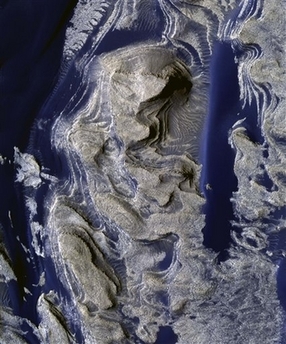 There’s a nice story about new photographic evidence from the Mars Reconnaissance Orbiter for water having flowed on Mars. It is not really as dramatic as the photographs of late last year, but it is still an important piece of the puzzle overall (so do read about it), if harder to sell to the public as a “stop-the-press!” type of story. So here’s how three different news agencies tried to bring you in:
There’s a nice story about new photographic evidence from the Mars Reconnaissance Orbiter for water having flowed on Mars. It is not really as dramatic as the photographs of late last year, but it is still an important piece of the puzzle overall (so do read about it), if harder to sell to the public as a “stop-the-press!” type of story. So here’s how three different news agencies tried to bring you in:
Not bad. The layering and colour gradations seen are is not direct evidence of water, of course. It could have been some other fluid flow, but…ok.
Next, we have: Click to continue reading this post
This is the Helix Nebula, as imaged by the Spitzer telescope. Another wonderful eye in the sky. See links at bottom for a couple more dramatic eye images. This is a planetary nebula, with a white dwarf star at its core, left over as the late stages of the life of a once vibrant star.What’s the story? Well, you can read at […] Click to continue reading this post
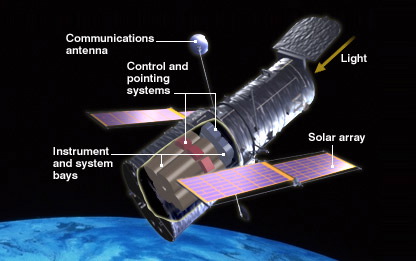 As you can tell by putting “hubble” into the blog’s search engine on the right, the Hubble Space Telescope has been a strikingly successful eye on what’s going on (and what went on) in the universe, and very powerful tool in lots of research. A lot of that research is done with the instrument called the Advanced Camera for Surveys (ACS), which have been the instrument in most heavy demand by researchers since it went online in 2002 (Hubble was launched much earlier, in 1990 of course). The instrument stopped working a few days ago (see e.g. stories here and here, [update: and especially here]), and is not expected to become operational again without direct intervention. Given that the Hubble orbits some 360 miles above the earth, this is not an easy thing to do.
As you can tell by putting “hubble” into the blog’s search engine on the right, the Hubble Space Telescope has been a strikingly successful eye on what’s going on (and what went on) in the universe, and very powerful tool in lots of research. A lot of that research is done with the instrument called the Advanced Camera for Surveys (ACS), which have been the instrument in most heavy demand by researchers since it went online in 2002 (Hubble was launched much earlier, in 1990 of course). The instrument stopped working a few days ago (see e.g. stories here and here, [update: and especially here]), and is not expected to become operational again without direct intervention. Given that the Hubble orbits some 360 miles above the earth, this is not an easy thing to do.
There are other instruments on board too, but the loss of use of this one is a heavy […] Click to continue reading this post
The Solar and Heliospheric Observatory (SOHO), a spacecraft that studies the sun, has been taking rather spectacular photos of comet McNaught. See here, for example. But the recent news that’s been exciting everyone are the comet pictures from the newer twin-spacecraft Solar Terrestrial Relations Observatories (STEREO), such as this one … Click to continue reading this post
’m watching my email for an invitation to fly suddenly to the Southern Hemisphere. Perhaps the Latin American Summer School (being held in Argentina this year) needs an emergency strings lecturer? I’ll be happy to reprise my lectures from the one I taught at in Mexico city in 2000…
Why do I want to go South with such urgency? This is largely because Comet McNaught continues to put on a wonderful show in the Southern Hemisphere. Amara Graps has kindly put several links for us to look at in the comment stream of my Look Up Down South post. Have a look here, here, here, here, and here. I did, and I found this lovely shot (by Mary Fanner – click for larger) of the comet over the beautiful city of Cape Town, which I miss a lot from the days when I helped run the ASTI science education program in 2004:
There are several more to be found on […] Click to continue reading this post
We’re more or less all done with comet McNaught up here in the North. We’ve handed it over to the Southern hemisphere viewers. That lucky lot are getting quite a show, since the comet seems to be outgassing more and producing a longer tail of debris. It is spectacular. Here … Click to continue reading this post
Comet McNaught seems to be a gift that keeps on giving. Last night here in Los Angeles, just after the sun set, I stepped out to look from a nearby elevated spot – and there it was. With binoculars, it’s an impressive sight, and possibly the last naked-eye visible comet sighting for a long time. Unfortunately, I have no equipment that I can use to take a decent photo for you, so I can’t share what I saw.
But you can go out and look. I give some viewing tips below.
What you’re probably puzzled about now is why the experts kept getting the “last chance to see” message wrong. People seemed very sure back on Wednesday that it would be gone from view -and I did a post to that effect myself- and and the same thing was said on Thursday and then on Friday.
I’m guessing that this is because although they can track the position rather well, they […] Click to continue reading this post
So the new comet, McNaught, is now very much a naked-eye visible object. Apparently it is the brightest comet in the last 30 years or so. I learned* that (for those in the Northern Hemisphere) Wednesday evening might well be the last chance to see it before it becomes a … Click to continue reading this post
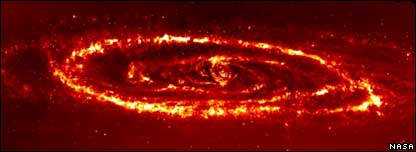 The Andromeda Galaxy is bigger than previously thought. Perhaps as much as five times bigger. I know that you’re thinking – “Oh, that’s because most of it is dark matter, right?” No, this is not another dark matter story. In fact, there are many newly discovered stars from a recent study! The suburbs of the galaxy are much more extensive than previously identified. It’s rather good news, since the galaxy makes more sense than it did before, in the context of our understanding of how galaxies form and evolve. (Image above is of Andromeda in the infra-red, from NASA.)
The Andromeda Galaxy is bigger than previously thought. Perhaps as much as five times bigger. I know that you’re thinking – “Oh, that’s because most of it is dark matter, right?” No, this is not another dark matter story. In fact, there are many newly discovered stars from a recent study! The suburbs of the galaxy are much more extensive than previously identified. It’s rather good news, since the galaxy makes more sense than it did before, in the context of our understanding of how galaxies form and evolve. (Image above is of Andromeda in the infra-red, from NASA.)
The point here is that current theories of evolution for galaxies have the oldest stars Click to continue reading this post
Have a look at this:

What is it? It is an image of part of the three dimensional (see below) distribution of clumps of dark matter in our universe, produced by an extensive survey using the Hubble telescope. How did they produce it, given that dark matter is -by definition- not visible? They deduced the presence of the chunks of dark matter by looking at the gravitational […] Click to continue reading this post
The Bad Astronomy Blog gives a top ten list of astronomy images for 2006. There are some really wonderful choices there, and Phil Plait gives a good deal of discussion of each one. The winner is this fantastic back-lit (by the sun, not some giant NASA flashgun) image of Saturn taken -of course- by the Cassini mission:
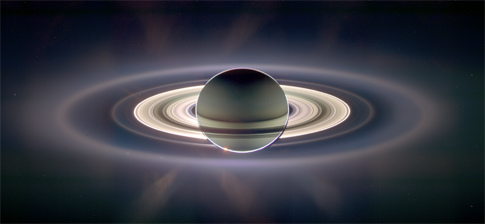
Now there’s another wonderful feature of this photo that makes it such a clear winner. […] Click to continue reading this post
This is a diagram of the layout of the equipment on the Corot (COnvection, ROtation and planetary Transits) space telescope, launched recently from a site in Kazakhstan:
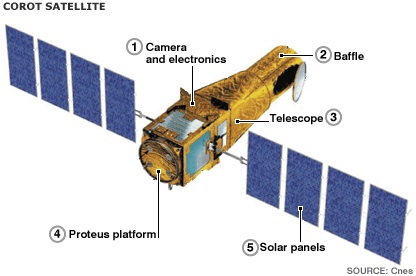
It’s a European Space Agency (ESA) mission, primarily run by the Centre National d’Etudes Spatiales (CNES – the French Space Agency, if you will) and it’s going to be looking closely at about 120,000 stars for signs of planetary bodies in orbit around them, in addition to studying the stars themselves. There’s a BBC story here, with video, more figured and images, and links to other sites, such as this condensed mission guide. The Proteus platform in the diagram refers to that fact that this is but one of a series of craft in the “Proteus†series, the platform itself being the design of the core containing the instrumentation and control systems of the device. Learn more about that here.
By going over to ESA’s site, you can learn a lot more about the scientific objectives and […] Click to continue reading this post
One sees them a lot around here, given the town I’m in, but that’s not what I’m talking about.
There’s a Spitzer telescope press release about the possible discovery of the most early stars detected to date. These would be the very first stars to have formed in the universe. Remembering that the universe is 13.7 billion years old, pause for a moment to be impressed by the claim of Kashlinsky, Arendt, Mather and Moseley that these stars appeared less than a billion years after the big bang. You should also read some discussion in John Baez’ recent post. [Update: See remarks from Ned Wright at the end of this post.]
The new milestone on the timeline of the universe’s history, if this is correct, would look roughly as in this image (from the press release):
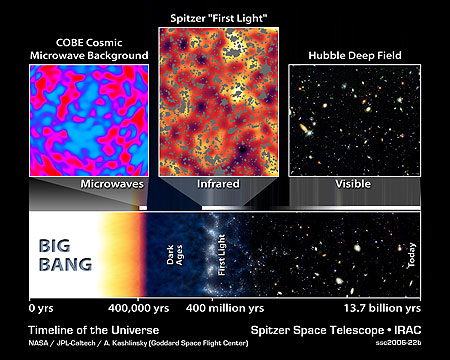
Extraordinary claims (like this one) require extraordinary evidence, and so there’ll no […] Click to continue reading this post